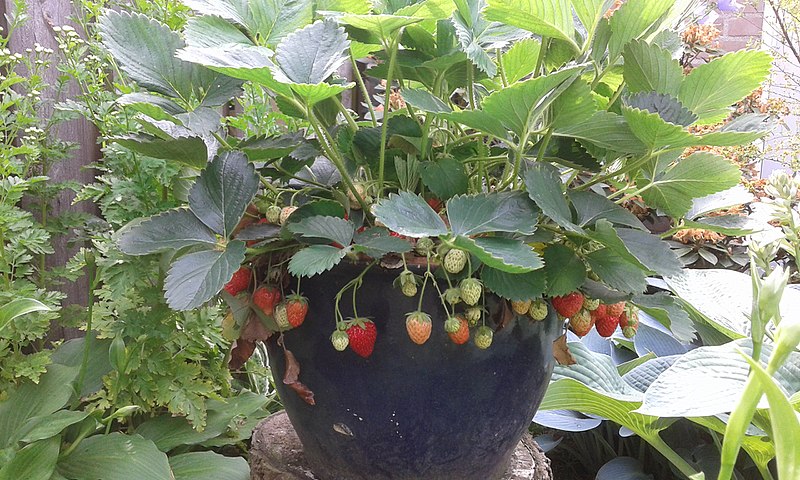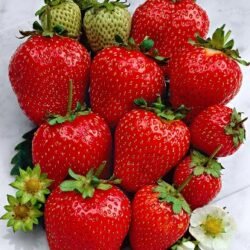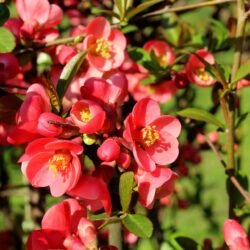Answering this question is not easy. Children, not without reason, are considered excellent strawberry connoisseurs for several reasons:
Continue reading “Which Strawberry Varieties Taste Best to Kids?”
Ants in the Garden. How to Fight These Uninvited Guests? Ecological Methods
Ants in the garden can be a problem; however, there are several effective ways to deal with these unwelcome guests while maintaining an environmentally friendly approach:
1. Vinegar:
Spray a solution of vinegar and water (in a 1:1 ratio) in places where you see ants. Vinegar is a natural deterrent.
2. Baking soda and powdered sugar:
A mixture of baking soda with powdered sugar can be effective, as ants are attracted to the sugar, and the baking soda kills them after ingestion.
3. Cinnamon:
Sprinkle cinnamon in places where you notice ants. It is a natural repellent.
4. Lemon solution:
Spray areas where ants gather with a solution of water and lemon juice. The acidic smell repels ants.
5. Diatomaceous earth:
This is a natural, non-metallic mineral powder that is effective in combating ants, acting as a desiccant.
6. Cucumber peel pieces:
Placing them in areas where ants gather can help deter them.
7. Crawling plants:
Some plants, such as mint, lavender, or basil, act as natural ant deterrents.
8. Sealing entrances:
Block all potential entrances for ants into the home, including cracks in walls and around windows.
9. Regular cleaning:
Removing food residues and maintaining cleanliness in the garden will help discourage ants.
10. Water barrier:
If you have outdoor pots, you can place them in a bowl of water, creating a barrier that ants cannot cross.
Remember that ants play an important role in the ecosystem, helping in the decomposition of organic matter and soil aeration. Sometimes the best strategy is simply to maintain balance and avoid excessive ant control unless they become a serious problem.
How to Overwinter Potted Strawberries and Care for Them in Spring?
To prepare strawberries in pots for wintering, you should🧐:
Continue reading “How to Overwinter Potted Strawberries and Care for Them in Spring?”
Should You Remove Strawberry Blossoms After Planting?
Removing flowers from strawberry plants is recommended for spring planting.🍓🌱
Continue reading “Should You Remove Strawberry Blossoms After Planting?”
Snails in strawberries. What to do? How to fight them?
Slugs can be a problem in strawberry cultivation, as these soft, moisture-loving creatures often feed on the leaves and fruits. There are several methods of combating slugs in strawberry crops that can be applied:
Physical Barriers:
Spread materials around the strawberries that make it difficult for slugs to move, such as ash, sand, fine gravel, or eggshells. Slugs do not like to squeeze through sharp or rough surfaces.
You can also apply special rings or barriers around the plants, made of plastic or metal.
Traps:
Setting traps for slugs is a popular method. The simplest trap is a bowl of beer, buried in the ground so that its edges are at ground level. Slugs are attracted to the smell of beer, fall into the trap, and drown.
You can also use traps purchased at a garden store.
Manual Collection:
Regularly checking the crops in the evening or early morning (slugs are most active at these times) and manually collecting slugs is a simple, but time-consuming method.
Biological Control:
Using natural predators, such as ground beetles or certain species of birds, can help control slug populations.
Introducing entomopathogenic nematodes, which naturally attack slugs, is another biological control method.
Chemical Means:
Chemical agents, such as slug pellets containing metaldehyde or iron phosphate, are effective but should be used with caution, especially in amateur crops. I personally advise against using these types of preparations, but if you decide to use them (they are effective), always follow the manufacturer’s instructions.
Maintaining Garden Cleanliness:
Removing plant residues, old leaves, and other shelters for slugs will help reduce their population.
Cultivating Repellent Plants:
Planting plants that naturally repel slugs, such as garlic, sage, or plants with a strong scent, near strawberries, can help deter slugs.
Remember to always choose slug control methods that are safe for the environment and do not harm beneficial organisms in your garden. In the case of using chemical agents, always follow the recommendations for their use to ensure that eating our strawberries is safe
Weeds In Strawberries – How To Deal With Them? Natural Methods
On large production plantations, the standard for combating weeds is the use of herbicides. Unfortunately, many studies indicate that they are not indifferent to our health, which is why I advise against their use in amateur strawberry 🍓 cultivation Continue reading “Weeds In Strawberries – How To Deal With Them? Natural Methods”
Shredded Twigs as Mulch for Strawberries: Feasibility and Benefits?
Of course, you can and definitely should.
Finely ground branches left over from pruning fruit trees can be successfully used as mulch for strawberries🍓 Continue reading “Shredded Twigs as Mulch for Strawberries: Feasibility and Benefits?”
Strawberry Pests: Identify and Conquer!
Strawberry pests can be diverse and require different control methods. Here are some common strawberry pests, ways to recognize them, and methods to deal with them:🙂
- Aphids:
Recognition: Small, usually green or black insects, often gather on the underside of leaves. Control: Use of natural predators, such as ladybugs, application of garden soap or chemical agents suitable for controlling aphids.
- Slugs and naked snails:
Recognition: Visible slime trails on plants and fruits.
Control: Manual collection, beer traps, use of anti-slug granules (with caution), maintaining a dry environment around plants.
- Insect larvae:
Recognition: Damage to leaves and fruits, larvae may be visible on plants or in the soil.
Control: Manual removal of larvae, use of appropriate insecticides, encouraging the presence of natural predators.
- Scale insects and mealybugs:
Recognition: Small, shield-like insects on plants or white, cottony spots.
Control: Spraying with isopropyl alcohol or garden soap, use of neem oil, manual removal.
- Spider mites:
Recognition: Tiny, red or yellow insects, spider webs on plants.
Control: Use of garden soap, neem oil, increasing air humidity, use of acaricides.
- Centipedes and millipedes:
Recognition: Damage to plants, presence of insects in the soil.
Control: Maintaining a dry environment, traps, limiting shelters.
It’s important to remember that the best approach is to use integrated pest management, which combines different pest control methods, from natural to chemical, depending on needs. Always use chemical agents in accordance with the label and pay attention to the possible impact on the environment and other organisms in the garden. Moreover, regular plant inspections and maintaining a healthy cultivation environment can significantly contribute to reducing the pest problem.
The Perils of Overcrowding Strawberry Plants?
Planting plants🌱 too densely is a common mistake among beginner gardeners. This is especially true for strawberries, which react very negatively to excessive crowding.
Continue reading “The Perils of Overcrowding Strawberry Plants?”
Strawberries in Your Garden – Easy Growing and Sweet Fruit All Season Long
Growing alpine strawberries is not difficult, and considering their undeniable taste and health benefits, it’s worth allocating a few square meters for them in every garden, no matter how small. Children and grandchildren will squeal with joy. 😁
Continue reading “Strawberries in Your Garden – Easy Growing and Sweet Fruit All Season Long”















